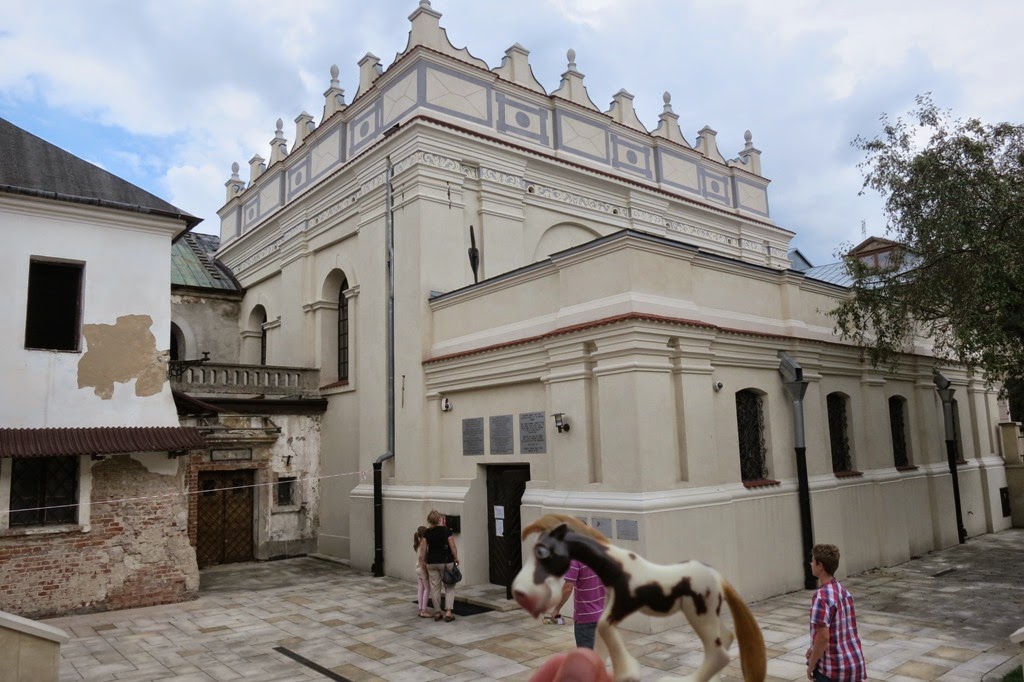I am very proud to take you today to yet another UNESCO World Heritage Site in Poland - the pearl of the Renaissance, the ideal city, in short - welcome to Zamość!
Zamość was founded in the sixteenth century and was the capital of the majorat (or fee tail) of one of the most powerful noble families - Zamojski. It was designed to be a perfect or ideal city - functional, safe, citizen-friendly and beautiful. The safety features can be best seen by the city walls.
To enter the city, visitors must have entered through one of many, well-guarded, gates. Some of them were smaller ...
... while others could easily let through big waggons pulled by horses.
As an additional protection, the city walls were surrounded by an external ring of moats. Today the moats no longer carry water - they have been turned up into parks and recreational areas.
The beating heart of Zamość is centered around it Great Market Square. It is truely square - a hundred meters long and a hundred meters wide. On the Northern side of the Great Market Square you will find the Town Hall. From its tower every day a trumpet call is being played. It is played to three cardinal directions - all except West one. The Zamojski family did not want the call to flow into the direction of Kraków, the capital city of Poland at that time. This was their way of showing they disapproved the royal political choices.
Each side of the square includes 8 residential buildings, except the one with the Town Hall.
To see them better I propose that we go up on the terrace of the Town Hall.
Here come the buildings on the Eastern and Southern side.
And here the most beautiful ones, at least in my view. The Armenian Houses were built in Mannerism-Baroque style and are very colourful. You can also find them on most postcards from Zamość.
When we move out of the Great Market Square the streets become slightly less interesting, though they still impress by their regular lines.
The Zamojski family was living, of course, in a huge palace. Nowadays it is the seat of the local and regional court of justice. In its current shape it does not inspire respect or fear as it probably used to three hundred years ago. The only memory of its past glory is the monument of Jan Zamojski and his faithful horse. The monument is very recent, it was only created in 2005.
An ideal, citizen-friendly city was obviously centered not only around the palace of the local nobility, no matter how powerful it was. Jan Zamojski has founded the Zamojski Academy, so a university, open to all inhabitants, including bourgeoisie. Today, the building houses a secondary school and still serves educational purposes.
Just a few steps from there you will find the seminary (or theological college) of Zamość. In the back you will see again the tower of the Town Hall.
You will not be surprised to hear that next to the seminary stands the Zamość cathedral. It was built towards the end of the sixteenth century, in Renaissance style.
It can be best seen by its ceiling (do you remember the gothic ceilings of the cathedral in Wrocław?).
Next to the ceiling there are 85 rosettes made of stone. Each has a different design.
Those of you who have been reading my blog for a longer time sure guessed that in this part of Poland Catholics could not have been the only religion in the past. You are right my friends - the tolerant Zamojski family has allowed Jews to live in their capital starting from 1588. In 1929 they constituted half of the city's population. Their most important place of prayer was the synagogue at Zamenhoffa Street, the best preserved Renaissance synagogue in Poland.
It has been recently refurbished and is being used as an art gallery. It is also an important element of the Chassidic Route.
One could think that a city that was designed in line with some utopic (in the best sense of the word) ideas will not survive the pressure of time. Well, quite the opposite. Zamość is a city still alive, with nice new buildings being added in the outskirts of the Old Town.
As in any case, it is dependent on the people who live there. Zamość was lucky to give to Poland one of it biggest poets and singers of the second half of the twentieth century - Marek Grechuta.
My favourite song by Grechuta is entitled "The days that we do not know yet". It brings a strong message that whatever happens in life the only moments that matter in life are these that are still to come.





















Miałam okazję być w Zamościu i zakochałam się w tym mieście. Kolorowe kamieniczki, piękne schody na Starym Mieście.. Odwiedziłam właściwie te same miejsca co Ty. Ale nie miałam pojęcia, że Marek Grechuta pochodził z Zamościa! Uwielbiam jego piosenki - "Będziesz moją panią", "Nie dokazuj"... :D
ReplyDeleteJa też uwielbiam Grechutę :)
DeletePocztówki z Zamościa przedstawiają zawsze Rynek. Dzięki Tobie zobaczyłam też inne obiekty tego miasta :)
ReplyDeleteI wcale nie tak łatwo kupić pocztówkę na której jest inna część starówki ;). Ale moim zdaniem naprawdę warto się przejść uliczkami Zamościa, są bardzo urokliwe.
DeleteNigdy nie byłam w Zamościu, ale jest on na mojej podróżniczej polskiej liście:) Uczyłam się o tym mieście na studiach, jednak zachwycało mnie ono już wcześniej. Ratusz, kamienice - dla mnie idealne miejsce :)
ReplyDeleteZdecydowanie warto!
Delete